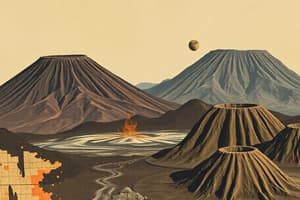Podcast
Questions and Answers
What primarily contributes to the low, broad profile of shield volcanoes?
What primarily contributes to the low, broad profile of shield volcanoes?
- Frequent explosive eruptions
- Steep angles of repose
- High viscosity lava flows
- Highly fluid lava flows (correct)
Which type of volcano is defined by its steep profile due to alternating layers of lava and pyroclastics?
Which type of volcano is defined by its steep profile due to alternating layers of lava and pyroclastics?
- Shield volcano
- Caldera
- Strato volcano (correct)
- Cinder cone volcano
What is the primary characteristic of cinder cone volcanoes?
What is the primary characteristic of cinder cone volcanoes?
- They are large basin-shaped depressions
- They have extensive lava flows
- They frequently erupt explosively
- They are formed from cinder-sized pyroclastics (correct)
How are craters typically formed during volcanic activity?
How are craters typically formed during volcanic activity?
Calderas are formed primarily as a result of what process?
Calderas are formed primarily as a result of what process?
What defines the formation of intrusive igneous rocks?
What defines the formation of intrusive igneous rocks?
What is a distinguishing feature of a batholith?
What is a distinguishing feature of a batholith?
What best describes the formation of a dike?
What best describes the formation of a dike?
Flashcards are hidden until you start studying
Study Notes
Classification of Volcanoes
- Volcanoes are categorized by shape and size, influenced by the volume/type of material ejected, eruption sequence, and environment.
- Common types of volcanoes:
- Shield volcanoes
- Strato volcanoes
- Cinder cones
- Craters
- Calderas
Shield Volcanoes
- Characterized by a broad and low profile, created by fluid lava flows.
- Lava typically consists of basalt and maintains a gentle slope, not exceeding 7 degrees.
- Hawaiian Islands are primarily formed of shield volcanoes, rising about 5 kilometers from the seafloor.
Strato Volcanoes
- Recognized as the most prevalent volcanic form with steep conical shapes.
- Composed of alternating layers of lava and pyroclastics, reflecting a complex eruptive history.
- Eruptions are explosive due to the viscosity of the lava, which does not spread far before solidifying.
Cinder Cone Volcanoes
- Formed by a conical accumulation of cinder-sized pyroclastics.
- The profile depends on the angle of repose, which determines the stability of debris.
Craters and Calderas
- Craters are created by the collapse of material during eruptions or through erosion during dormancy.
- Calderas are larger, basin-shaped depressions formed when a magma chamber drains and causes the overlying structure to collapse.
Intrusive Igneous Rocks
- Form from magma that solidifies beneath the Earth's surface, resulting in various landforms.
- Types of intrusive rocks include:
- Batholiths: Large dome-shaped intrusions extending over hundreds of square kilometers.
- Sills: Near-horizontal intrusions between rock layers, creating sheets parallel to surrounding rocks.
- Dikes: Vertical sheets that form when magma rises through cracks and cools.
Eruption Styles and Lava Types
- Eruption styles and lava composition differ based on plate boundaries.
- Basaltic lava primarily emerges from oceanic divergence zones and mid-ocean volcanic sites.
- Andesite and basalt are common where ocean plates collide.
- Consolidated ash flows occur at zones where oceanic and continental plates converge.
Historical Eruptions
- The 1883 eruption of Krakatoa resulted in a massive tsunami, devastating the coasts of Java and Sumatra, and causing over 36,000 fatalities.
Studying That Suits You
Use AI to generate personalized quizzes and flashcards to suit your learning preferences.




